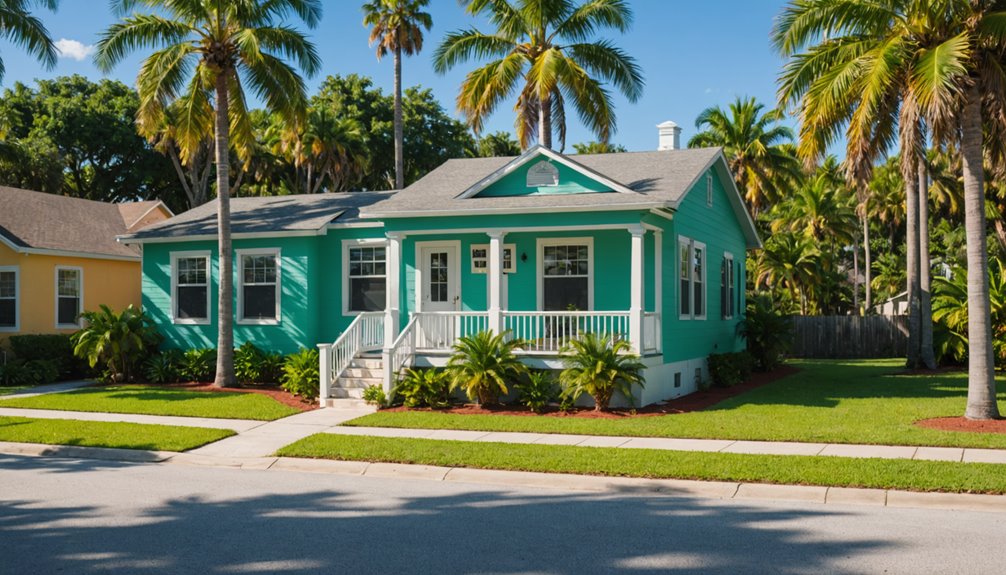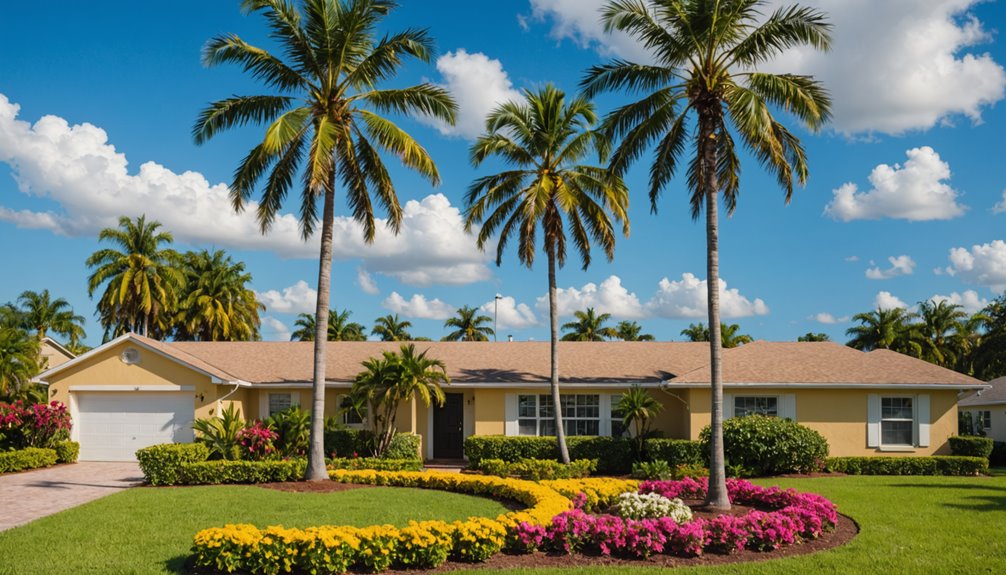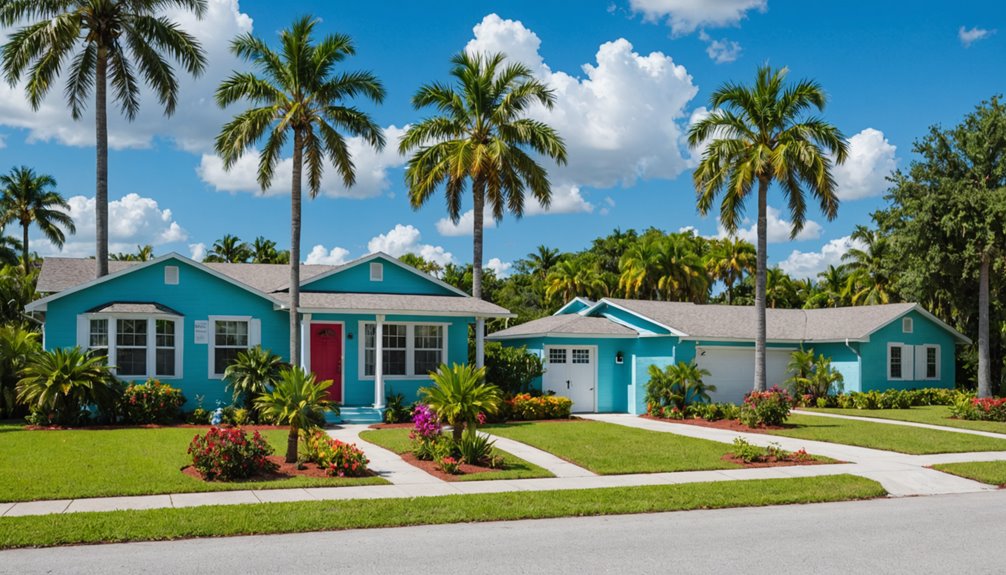Florida’s real estate market follows clear seasonal trends that affect both buyers and sellers. Seasonal trends in home prices show that demand rises in the cooler months, especially from October to April. Many snowbirds and vacation home buyers from colder states flood the market, creating competition and pushing prices higher. Sellers can take advantage of this busy season to list their homes at a premium. In popular coastal areas like Naples and Sarasota, home prices during peak season can be 5-10% higher than in the summer months.
On the flip side, summer often brings a slowdown in sales. Families settle in before the school year, and fewer out-of-state buyers are looking. Seasonal trends in home prices reveal that during the hotter months, inventory rises, leading to lower prices and better deals for buyers. Additionally, the threat of hurricanes makes some buyers hesitant to purchase during this time. This trend is even more noticeable in coastal regions, where price drops tend to be steeper compared to inland cities like Orlando and Lakeland, which see more stable pricing.
Savvy buyers and sellers use these trends to their advantage. If you’re looking to sell, listing during the high-demand season can maximize your profits. Buyers who wait until summer can find better deals and negotiate more favorable terms. Whether you’re buying or selling, understanding these seasonal patterns gives you an edge in Florida’s competitive real estate market. Let’s make smart moves together!
Key Takeaways
- Florida home prices peak from October to April due to increased demand from seasonal buyers, known as “snowbirds.”
- Winter demand surges as tourists seek warmer climates, intensifying competition for vacation and primary residences.
- Summer months typically see slower sales and increased listings due to hurricane risks and rising costs, straining buyer budgets.
- Coastal properties face price declines from rising inventory and economic pressures, while inland areas show modest price increases due to affordability.
- Strategic timing for listings during peak seasons can optimize seller returns and attract buyers, while off-season strategies can expand the buyer pool.
Seasonal Price Fluctuations in Florida Real Estate
How do seasonal trends impact home prices in Florida’s genuine estate market? In Florida, home prices exhibit significant fluctuations throughout the year, primarily influenced by seasonal demand. During peak seasons, especially from October to April, the influx of seasonal buyers, often referred to as “snowbirds,” intensifies competition, driving prices upward.
For instance, Northeast Florida’s median home price saw a notable 2.3% increase in December 2023, indicative of robust winter market activity. Additionally, understanding mortgage preapproval can help buyers take advantage of favorable seasonal conditions. Conversely, the summer months typically experience slower sales, as heat and hurricane risks deter buyers, leading to reduced prices.
This seasonal dynamic, characterized by high demand and limited inventory, underscores the importance of timing in Florida’s genuine estate landscape, presenting both challenges and opportunities for prospective homeowners. Additionally, the restricted housing inventory further exacerbates price fluctuations, as demand often outpaces supply, especially during peak seasons.
The Impact of Winter Demand Surge
As winter approaches, the Florida genuine estate market experiences a pronounced surge in demand, mainly driven by the influx of seasonal buyers seeking warmer climates. This seasonality is especially evident as snowbirds and remote workers converge, intensifying competition for both vacation and primary residences. The presence of extended-stay tourists further fuels interest in property acquisition, especially in amenity-rich coastal areas.
Competitive mortgage rates and investment in vacation rentals spikes, aligned with peak tourist seasons that promise higher rental yields. Although new listings increase, the market’s low inventory exacerbates buyer competition, prompting sellers to navigate pricing challenges. Overall, the winter demand surge not only influences market dynamics but also reflects Florida’shousing market’s broader demographic shifts, creating a vibrant, albeit competitive, genuine estate environment in Florida.
Summer Market Softening Trends

While the summer months typically bring a slowdown in the Florida authentic estate market, recent data highlights a multifaceted softening trend driven by diverse external factors. The aftermath of Hurricane Ian has led to a surge in listings as damaged properties re-enter the market, yet rising insurance costs and increased HOA fees have strained buyer budgets. Concurrently, buyer caution is amplified by the hurricane season, with a notable decline in condo demand due to heightened risk perception.
Inventory levels have swelled, especially in single-family homes, resulting in price cuts becoming more prevalent. Research affordable neighborhoods can help buyers identify areas that may offer better value during this market shift. Urban centers maintain stronger demand, while rural regions lag, illustrating regional disparities that complicate the summer market landscape.
Additionally, 66% of Florida single-family markets are showing year-over-year price declines, further reflecting the ongoing challenges in the housing market.
Coastal vs. Inland Price Dynamics
Coastal and inland markets exhibit unique price variation patterns driven by differing seasonal demand dynamics. In 2024, coastal regions faced significant price declines due to rising inventory and external economic pressures, while inland areas demonstrated resilience with modest price increases fueled by a shift towards affordability. This contrast underscores the interplay between regional market conditions and buyer preferences, highlighting how external factors can shape genuine estate trends.
Notably, the statewide median list price in September 2024 is $437,251, reflecting the broader challenges in the Florida housing market.
Price Variation Patterns
Although regional factors greatly influence property prices, distinctive price variation patterns emerge when comparing coastal and inland markets. Seaside properties, specifically condos, are experiencing significant price declines due to increasing insurance costs, regulatory fees, and heightened vulnerability to hurricanes. These factors diminish affordability, prompting some buyers to migrate inland.
In contrast, inland single-family homes showcase resilience, with modest price increases attracting those seeking cost-effective living options. Rising insurance costs and lower insurance premiums further improve the appeal of inland areas, while their diverse landscapes provide a quieter lifestyle. Altogether, these contrasting dynamics highlight a shift in buyer preferences, suggesting a potential genuine realignment of Florida’s real estate landscape as affordability becomes a critical deciding factor for many.
Seasonal Demand Impact
Seasonal fluctuations play a significant role in shaping price dynamics across coastal and inland markets. During the winter months (October-April), coastal properties experience heightened demand due to tourism and snowbird activity, propelling prices upward. Conversely, the summer months witness a decline in interest, specifically in the condo market, with prices dropping by 1.3% year-over-year. Inland markets, however, demonstrate resilience, with single-family home prices rising by 2% year-over-year amidst affordability concerns.
The disparity in demand is further accentuated by increasing insurance costs affecting coastal properties, leading to a 12% decline in condo demand since 2022. This bifurcation in market dynamics underscores the complex interplay of seasonal trends and buyer preferences across Florida. Additionally, seasonality significantly influences Florida home prices, making it crucial for sellers to time their listings effectively.
Seller Strategies During Peak Seasons

As warmer weather arrives and families shift for the school year, sellers can capitalize on peak seasons by employing targeted strategies that boost market visibility and buyer engagement. Timing listings for spring and winter can notably improve exposure, attracting families and snowbirds seeking to relocate. Premium pricing during high-demand periods guarantees sellers optimize returns, while competitive pricing in the fall can maintain interest amidst reduced inventory.
Emphasizing local amenities, such as schools or recreational facilities, resonates with potential buyers. Additionally, selling during winter attracts out-of-state buyers, particularly snowbirds escaping colder climates, which can expand the potential buyer pool. Sellers can also mitigate off-season challenges by revitalizing properties and offering buyer incentives, guaranteeing they remain appealing throughout the year.
By adapting strategies to regional variations, sellers can effectively manage Florida’s distinctive market dynamics, especially during peak selling seasons when buyer demand is at its highest.
The Role of Tourism in Pricing Shifts
Tourism plays a pivotal role in shaping genuine estate pricing shifts, specifically in regions heavily frequented by vacationers. High tourist traffic in Florida cities like Orlando and Miami drives property values upward, particularly for vacation rentals and coastal homes. Seasonal trends reveal several critical influences:
- Increased demand for alternative homes during peak seasons
- High rental income potential from short-term vacation rentals
- Improved property values due to tourism-related infrastructure development
As winter approaches, the influx of snowbirds heightens competition for properties, leading to significant price escalations. The dual-income potential from rentals and long-term appreciation attracts investors, fostering a thriving genuine estate market. This dynamic relationship between tourism and pricing creates a sense of belonging for both residents and investors in these vibrant communities. Additionally, the shift to remote work flexibility has further influenced demand for vacation homes as more individuals seek to combine work and leisure.
Inventory Dynamics and Their Effects

The interplay between inventory dynamics and home prices reveals significant insights into market behavior, particularly during seasonal fluctuations. In December 2024, new listings fell by 12.8%, indicating diminished seller activity amid winter conditions. Despite a 4.5% decrease in active inventory, it remained 66.7% higher than the previous year, showcasing annual growth.
This environment contributed to a 32.8% drop in pending sales, while median days on the market rose to 55, signaling slower property turnover. Conversely, January 2025 saw a 72.6% year-over-year increase in active inventory, enhancing buyer opportunities. The surge in listings not only fosters a balanced market but also supports affordability, allowing buyers to navigate choices with greater confidence and reduced competition.
Additionally, understanding market dynamics can help buyers make informed decisions during these fluctuations.
Long-Term Trends in Seasonal Pricing
While seasonal pricing trends exhibit notable fluctuations driven by diverse market forces, a deeper analysis reveals the underlying patterns that shape long-term pricing dynamics.
- Winter demand peaks: Prices are traditionally higher from October to April due to seasonal residents and investors.
- Summer slowdowns: Increased risks from heat and hurricanes lead to decreased transactions and potentially lower prices.
- Regional disparities: Coastal areas experience sharper swings compared to inland regions, influenced by tourism and retirement migration.
Over time, these seasonal cycles contribute to a more complex market landscape. While short-term variations are evident, the long-term appreciation trajectories, driven by factors such as inventory equilibrium and demographic shifts, ultimately, the housing market, create opportunities for both buyers and investors alike.
Frequently Asked Questions
How Can I Predict Future Home Prices in Florida?
To predict future home prices in Florida, one should analyze demographic trends, economic indicators, and housing supply-demand dynamics while considering factors such as population growth, remote work influence, and regional attractiveness to potential buyers.
What Factors Influence Home Prices Beyond Seasonal Trends?
Numerous factors play a significant role in home prices. Economic conditions, demographic shifts, infrastructure accessibility, and property characteristics collectively dictate market dynamics, influencing buyer behavior and ultimately shaping housing demand and values.
Do Seasonal Trends Affect Rental Prices in Florida?
Seasonal trends notably impact rental prices in Florida. Winter surges due to increased demand from snowbirds, while summer experiences a downturn. This cyclical pattern creates opportunities for both landlords and renters throughout the year.
When is the Best Time to Buy in Florida?
The best time to buy depends on your goals, but seasonal trends in home prices show that summer and early fall often offer the best deals. With more inventory and fewer buyers in the market, sellers may be more willing to negotiate, giving buyers a chance to save money and secure better terms.
How Do Local Events Impact Home Prices Seasonally?
Local events considerably influence home prices seasonally; increased demand during peak tourist seasons drives prices up, while off-season factors like hurricanes and heat can depress market activity, creating unique trends dependent on regional dynamics and inventory levels.
Are There Specific Neighborhoods With Unique Seasonal Price Trends?
Individual neighborhoods often exhibit singular seasonal price trends; for instance, the Walt Disney World Corridor sees winter rental income spikes, while coastal areas like Key West face volatility, highlighting the varied impact of location on pricing.
Essential Key Takeaways on Florida Housing Market TrendsConclusion
Understanding seasonal trends in home prices in Florida helps both buyers and sellers make intelligent decisions. Winter brings higher demand as snowbirds and tourists look for homes, often driving prices up. In contrast, summer tends to slow down, with more homes on the market and fewer buyers, leading to better deals. Coastal areas like Miami and Naples often see more significant price shifts than inland cities like Orlando or Tampa. By recognizing these patterns, you can plan the best time to buy or sell.
Real estate markets change constantly, and seasonal trends in home prices are just one piece of the puzzle. Local factors, economic conditions, and unexpected events can also impact pricing. To make the best decision, work with an experienced local realtor or broker who understands the market in your area. They can provide up-to-date insights and help you navigate Florida’s real estate trends.
References
- https://www.homeinc.com/blog/how-does-seasonality-impact-home-prices/
- https://www.homeinc.com/blog/analyzing-florida-home-price-trends/
- https://www.noradarealestate.com/blog/florida-housing-market/
- https://www.prnewswire.com/news-releases/florida-realtors-2025-real-estate-trends-whats-ahead-for-flas-housing-302367555.html
- https://www.redfin.com/state/Florida/housing-market
- https://www.floridarealtymarketplace.com/blog/when-will-real-estate-prices-drop-in-florida-best-time-to-buy.html
- https://www.whatsupjacksonville.com/december-trends-reflect-seasonal-shifts-with-fluctuating-prices-and-inventory-growth/
- https://www.anchorloans.com/blog/why-floridas-real-estate-market-is-unique-understanding-seasonal-buyers-and-trends
- https://nefar.realtor/news/2025/02/11/featured/northeast-florida-housing-market-sees-seasonal-changes-as-inventory-rises-in-early-2025/
- https://www.sandyhartmannhomes.com/blog/322074/Why+The+Florida+Housing+Market+Wont+Slow+Down+This+Winter







